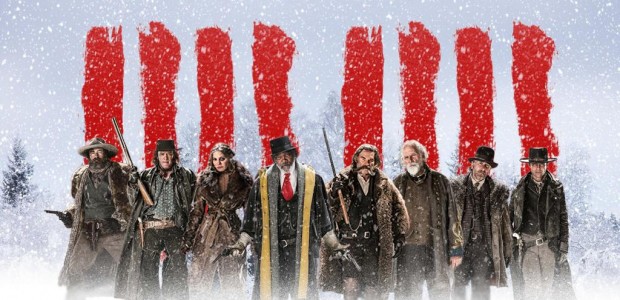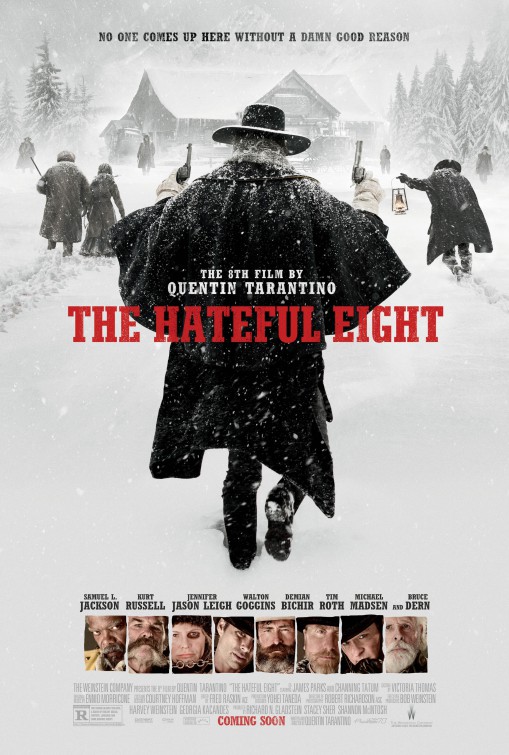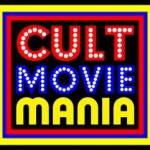Here now at the calendar’s end of 2015, which has been a particularly contentious and politically charged year in American history by any measure, it might be impossible to separate a film as provocative as THE HATEFUL EIGHT from context. The dominant sociopolitical issues of 2015 have been gun violence and the much-debated use of lethal force by appointed authorities. THE HATEFUL EIGHT isn’t, I don’t think, an “issues” movie. But in 2015, it’s probably not realistic or even possible to be apolitical. Any reading of a film itself is going to be obscured and complicated by the world into which it has now entered.
Quentin Tarantino, the writer, director, and narrator of the film, made absolutely sure that THE HATEFUL EIGHT could be no island by making headlines ahead of its release, joining high-profile protests and referring to those police officers who caused the deaths of unarmed suspects in scattered, specific incidents as “murderers.” I’m not even going to qualify the degree to which I agree or disagree with that pronouncement. I just can’t write about this movie and pretend I don’t know about it. Could anybody?
That’s the problem. Context is hard to ignore. I run a site called Daily Grindhouse. Our logo has a girl with a gun. We exist to promote and enjoy the kinds of films Quentin Tarantino makes. Over the past year, that’s become a bit of a quandary for me. An editorial has been percolating for a while now and it may as well happen right here — I feel a moral obligation to qualify my stance when my byline appears underneath the iconography of a woman holding a rifle. It’s true that I didn’t create that logo. First as a writer for the site and then as its editor, I inherited it. But neither am I renouncing it.
Honestly, I like the logo. It tells you quickly what kinds of films we cover. While that hardly addresses the full range of my personal cinematic interests, those are some of the kinds of films I most enjoy. I like that it’s a woman, not a man, holding the gun in that logo. I don’t think I would like, or endorse, the logo if it were a man holding a gun and not a woman. For this site I have written frequently about the action films of Pam Grier. I believe her stardom in the 1970s was revolutionary, and valuable, in the simple way that holding a gun in America is a traditionally masculine image, and a strong woman like Pam Grier powerfully subverted that. I’m interested in that sort of revolution by way of pop culture. I believe I admire and appreciate femininity, though I don’t profess to understand it. It’s been important to me that this site has as many female voices as male ones, though my level of success on that front can be fairly critiqued.
On the matter of guns, I have conflicted opinions. Very close friends of mine own guns, but I don’t, and the one time in my life I fired a gun, it was very clear to me that this was a serious responsibility which shouldn’t be accorded to just anyone — myself absolutely included. I do not keep a gun collection. But take a look at my movie collection. It was a sobering realization for me to realize that easily half of the movies I enjoy most would not have sustainable storylines if the element of guns were removed. There is the side of me that is socially progressive and more left-leaning than not, and then there is the side of me, like every other grown-up little boy, that clearly likes guns. I am, after all, an American. I don’t think violent movies should be censored. I like to think I can separate fantasy from reality. But it troubles me that my eight-year-old niece goes to the same elementary school that I went to as a kid and the major difference now is that she has to practice lock-down drills. This country clearly has a pressing problem with guns. I cannot see how an ethical person could possibly be against reasonable gun control measures in real life. That said, I would hate to give up watching the reactionary Charles Bronson movies I love so well. Am I a hypocrite?
All of these things matter, or they should, when taking into account THE HATEFUL EIGHT.
This is a movie about a group of violent characters who are holed up in a one-room establishment in the middle of a blizzard, and their dislike and distrust of each other leads to near-total destruction — yes, by gun violence. There is much profanity. There are reams of racist invective directed at the film’s sole black character, who is also the film’s biggest star. Via flashback, there are a few women in the story, but there is only one really prominent female character, played (in what is arguably the film’s most unusual and intriguing performance) by Jennifer Jason Leigh. This character, Daisy Domergue, begins the movie with a black eye and proceeds to be battered around throughout the nearly three hours of running time. She’s a wanted criminal but the precise charges are never named, and she begins the film as the prisoner of John Ruth (played by Kurt Russell), who spends most of the movie shackled to her, a la THE DEFIANT ONES, and who has no reservations about striking her to keep her in line. It’s worth noting, since this essay opened by referencing Quentin Tarantino’s incendiary statements about the police, that John Ruth is a bounty hunter, not a sheriff. So I don’t think John Ruth in THE HATEFUL EIGHT can rightly be looked at as an indictment of the police, one way or another. The only character in the film who claims to be a law officer is Chris Mannix (played by Walton Goggins of The Shield and Justified in the culmination of everything he did on those two series), and his authority is frequently disputed and ultimately never proven. My point is that the politics of the piece are ambiguous at best.
In a way, that’s apt. The many people who are bound to misunderstand THE HATEFUL EIGHT will inevitably do so because they can’t recognize its genre. They see horses and handguns and assume it’s an American Western, of the sort established in the collective imagination by populist practitioners like John Ford or Kevin Costner. Due to the extreme violence and arguable misanthropy, some might look to Sam Peckinpah for reference, but Peckinpah’s Westerns were intensely personal in a way I don’t think Tarantino’s work is. In fact, THE HATEFUL EIGHT is a “spaghetti” Western. It’s made by an American-born director with a mostly-American cast and American financing, but the true point of inspiration is found with those amoral, lurid, ultra-violent, boistrous, energetic, bizarre Italian films of the 1960s and 1970s. Tarantino’s favorite movie is THE GOOD, THE BAD & THE UGLY and so is mine. So yes, I do have to argue that I see where he’s coming from, maybe better than many other critics out there might. We love the same things.
In light of THE HATEFUL EIGHT, it’s worth name-checking THE GOOD, THE BAD, AND THE UGLY. Sergio Leone’s movie runs 177 minutes. Tarantino’s runs within ten minutes of that, give or take (depending on which version you’re looking at). If you read what I wrote about THE GOOD, THE BAD & THE UGLY, you will see me struggling with the fact that it is not a particularly moral movie, despite the fact that its title very literally references moral concepts. Clint Eastwood is not too much more “good” than Lee Van Cleef is in that movie. They’re both looking to take money they didn’t earn, and willing to kill each other to do it. We’re supposed to look at Clint Eastwood’s character as good because he looks like Clint Eastwood, and maybe because he gives a dying soldier a smoke, but that’s really all that differentiates him from his black-hatted nemesis.
As a director, Sergio Leone was generally speaking more of a romantic sort than Quentin Tarantino is, but even still, the only substantial female character in THE GOOD, THE BAD & THE UGLY is a woman who Lee Van Cleef’s character beats for information. While Pam Grier in JACKIE BROWN is adored by the camera as much as Claudia Cardinale is in ONCE UPON A TIME IN THE WEST, that’s not what’s going on here. And as much as Tarantino looks to Leone for inspiration, he’s really been riffing on Sergio Corbucci — DJANGO‘s influence on DJANGO UNCHAINED being the most obvious, but the crushing nihilism of THE GREAT SILENCE is certainly a pivotal antecedent to THE HATEFUL EIGHT. It’s no accident that Tarantino was determined to get Ennio Morricone to do the score this time around.
Before arguing the merits or otherwise of THE HATEFUL EIGHT, one should understand the source. Most won’t. That isn’t to say there can’t or shouldn’t be a debate over it. But it’s worthwhile to start with the right frame of reference. The “spaghetti” Western is a lawless genre. I’m a lifelong aficionado and I still agonize over just why I love it so much. For whatever sociopolitical reasons, “spaghetti” Westerns were vile and violent. Hailing from the same country and the same era that brought us the giallo and the poliziotteschi, the “spaghetti” Western had way more sex and more violence than any of its American counterparts, and sometimes sex and violence were intertwined in uncomfortable ways. What Quentin Tarantino and his frequent onscreen collaborator Samuel L. Jackson bring to the “spaghetti” Western is the element of racial friction, but the shocking and probably needless violence in THE HATEFUL EIGHT, and certainly its remorseless treatment of its sole female lead, hail directly from genre convention.
“Spaghetti” Westerns are not kind to women, or to anybody really. They’re brutal, vicious things, and there often is no redeeming message. What moral could anyone take from THE GREAT SILENCE besides “sometimes evil wins?” What does THE GOOD, THE BAD & THE UGLY tell us about the Civil War (when it is set) or the tumultuous decade when it was made? It’s my favorite movie, and still I’d argue it tells us virtually nothing about those things. It’s just a movie.
But it’s 2015. Does a movie need to be more than just a movie?
I’ve written before about the notion of the fetish director, of which Quentin Tarantino is the most obvious example. (Alfred Hitchcock was one, if you want to go back further.) Few directors have been so forthright about the pleasures they get from their own movies. Quentin Tarantino has been very honest about the enjoyment he gets from violence in films. In taking his recent political position he has at least given lip service to the idea that he is against violence in real life. Generally speaking, he seems to know the difference. But there’s no doubt the violence in THE HATEFUL EIGHT is meant to be enjoyed. In a scene halfway through the film, where two characters are vomiting absurd amounts of blood after being poisoned by an assassin, the desired effect on the part of the writer and director seems to be laughter. As staged, it almost plays like a scene from EVIL DEAD II. Part of the joy of horror films is to view as entertainment horrendous sights that would (or should) be endlessly traumatic if they happened in everyday life. This has been written about critically to no end: Horror is a sort of release for the daring viewer. It stands to reason that action films, and Westerns, are a similar breed. There’s something thrilling about the proximity to death, whether imagined or tangible.
[Semi-spoiler imminent:] I thought about that in the final scene of THE HATEFUL EIGHT, when two characters cackle at the death by hanging of a third. This is how people were entertained, once upon a time. Westerns, as a genre, are full of scenes where townspeople gather to watch public hangings. They didn’t have movies back then. One way or another, the human instinct seems to be to want to interpret death as a spectacle.
To me, in 2015, the most pressing question as a movie-goer, as a movie-obsessive, is: What is my responsibility? I know that when I drive past a bad car accident, my animal instinct is to look, but my moral response is to look away, to make the effort to override that animal instinct, to try to give any potential victims the dignity I would want to be afforded were our places reversed. It’s a question worth asking in an age where people are literally dying in movie theaters. I admired and enjoyed THE HATEFUL EIGHT in the same way I watch so many violent and ultimately morally empty “Spaghetti” Westerns. Can I just leave it there? Can I compliment or defend a movie that does not reflect my own personal sense of morality? Or do I have an obligation to contradict my own instincts?
There is undeniable craft here. The performances (particularly those from the aforementioned Jennifer Jason Leigh, Sam Jackson, Demián Bichir, and Michael Madsen) are wickedly delightful. The dialogue is thrilling in its unpredictability. The imagery captured by Robert Richardson, particularly if you get a well-tended 70mm projection like I did, is luxurious even when the most ugly events are transpiring. Tarantino is without question a self-indulgent director, and there’s no reason the story he tells here should last almost three hours as it does, but that was also true of Leone, and Tarantino’s directorial achievement is to keep those three hours as absorbing as possible, for me anyway.
That said, and to circle back around to encompass everything I led with, it’s fair to consider THE HATEFUL EIGHT in the context of its time. It’s fair to ask an artist to be accountable for their art. It’s fair to bring the filmmaker in full light of his films, particularly because this is a filmmaker who directly brings himself and his predilections into those films. And it’s fair to publicly contemplate my own reactions to a Tarantino film, particularly because I’m convinced it exists to provoke them. I can’t separate Quentin Tarantino from THE HATEFUL EIGHT; I can’t write a completely objective review.
Complicated reactions have been part of my Tarantino experience from the start. PULP FICTION is visually vibrant and formally thrilling and culturally influential, yet the “dead nigger storage” scene remains as awkward and jarring to me as ever. Few films as objectively good as INGLOURIOUS BASTERDS contain anything as objectively bad as the performance by Tarantino’s friend Eli Roth. And in THE HATEFUL EIGHT, Quentin Tarantino appears himself — by voice — to narrate the film. That’s distracting. Some of the finest actors in the world appear in this film, but no one goes to a Tarantino movie hoping to see or hear him act in it. His proven strengths are behind the camera. His authorial voice is plenty strong enough without hearing it literally. He’s smart and self-aware enough to know all of that, and assertive and self-confident enough to go ahead with it anyway. Good for him, seriously, but he has to know he’s inviting criticism of himself as much as his movies.
His own satisfaction comes first; the audience’s comes second. In 2015, with the year we’ve all had, it’s fair to ask if that’s justification enough for a filmmaker. I don’t get the sense Tarantino is personally racist or misogynist but I also don’t get the sense he’s too concerned about the real racism and misogyny in the world. His movie is not immoral, but amoral. It’s a true “spaghetti” Western, which is an odd thing to make in this day and age. Again, I like it — it’s almost specifically geared to my tastes — but I do question my own response.
Nothing exists in a vacuum, least of all Tarantino movies. As much as I enjoy and respect the craft of his movies, it’d be disingenuous for me to ignore the very real issues they raise. I generally like Tarantino movies, and I very much liked this one, yet as a human being I have a visceral and negative reaction to seeing women hit in the face (and yes that’s a double-standard), I don’t agree that white writers have free reign over the word “nigger,” and I do occasionally feel obliged to attempt to reconcile my enjoyment of violent movies with the very real violence going on in my country. It’s up to me to struggle with that. My own unique humanity is inseparable from my movie-going eye. After all, just as Quentin Tarantino tends to insert himself onscreen, I tend to bring myself with me to the theater, right? My enjoyment of his films and my discomfort with some aspects of them are part of the story, and so is yours.
— JON ABRAMS.
LOOKING FOR UNDERGROUND CULT MOVIES, DVDs, LIMITED VHS & OTHER COOL STUFF.
CHECK OUT THE DAILY GRINDHOUSE/CULT MOVIE MANIA STORE
- [THE BIG QUESTION] WHAT’S YOUR FAVORITE FEMALE ENSEMBLE IN MOVIES? - July 22, 2016
- [IN THEATERS NOW] THE BOY (2016) - January 24, 2016
- Cult Movie Mania Releases Lucio Fulci Limited Edition VHS Sets - January 5, 2016
Tags: America, Editorial, Ennio Morricone, Guns, Jennifer Jason Leigh, men, Opinions, Quentin Tarantino, Samuel L. Jackson, women









No Comments